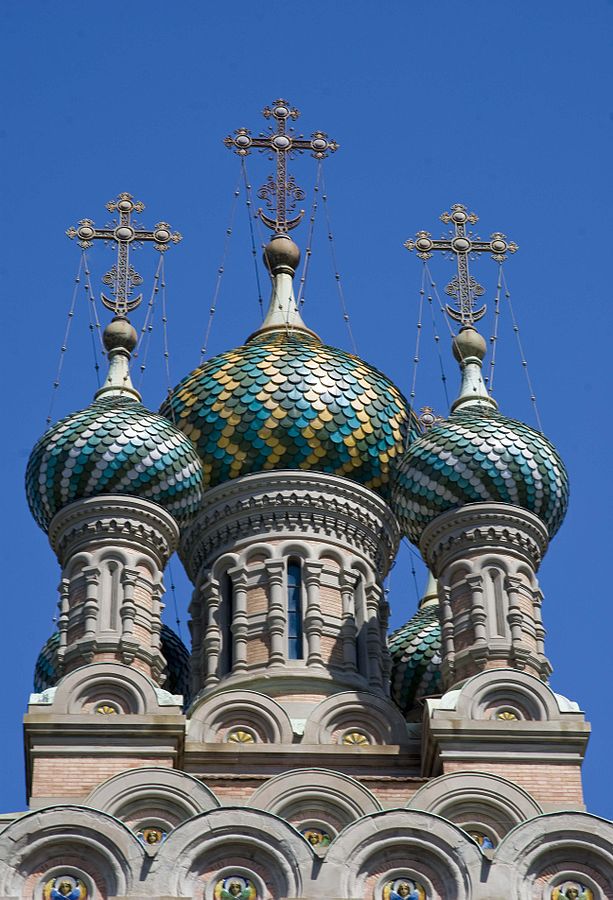A short walk from piazza della Libertà, an architectural gem stands nestled set back from a street named after Leone X, the first Medici pope, Giovanni de’ Medici (1475–1521), a leading Renaissance figure, famous, amongst other things, for having excommunicated Martin Luther in 1521. This unique and ornate construction is the Russian Orthodox Church of the Nativity of Christ and Saint Nicholas the Thaumaturge, more simply known to Florentines as the “Russian church”. After the small but elite Russian colony resident in the city had long and insistently called for a permanent place of worship, it finally came to fruition between 1899 and 1903. A combination of Russian and Italian artistry, the first Russian Orthodox church to be built in Italy was designed by Russian architect Mikhail Preobrazhensky (1854–1930), who had trained at Moscow’s Academy of Arts, and erected under the supervision of Italian architects Giuseppe Coccini (1840–1900) and, following his sudden death, Giovanni Paciarelli (1862–1929).

You are approaching the Russian church when you glimpse one large central onion-shaped dome and four smaller ones covered with bright turquoise, green and white scales of majolica (manufactured by the Cantagalli factory of Florence), topped with gilt crosses and chains. Laid out in the form of a Greek cross, the church is surrounded by an iron railing fence with three monumental gates decorated with the double-headed imperial eagle and Florentine lily forged by the Michelucci foundry of Pistoia. The church itself, constructed in red brick and grey stone from quarries near Fiesole, is furbished with 52 semi-circular or ogival arches known as kokočniki (named after the traditional Russian female headdress) featuring six winged cherubs, like those of the Cathedral of the Resurrection of Christ or, as it is better known, the Church of the Saviour on Spilled Blood in St. Petersburg. Above the doorway, a canopy houses a Venetian-made mosaic icon of “Znamenie”, the mother of God, between stems of flowering lilies with, nearby to the right and left, two other tabernacles with mosaics of the Apostles Peter and Paul. The splendid entrance door, which came from the private chapel at Villa Demidoff at San Donato, was inspired by Ghiberti’s Gates of Paradise. Depicting 22 scenes from the Old Testament, it had won its creator Rinaldo Barbetti first prize in a national exhibition in Florence in 1861.
Typical of Orthodox churches in northern Russia at the time, the Florence church was built on two storeys: the lower church designed to be warmer in winter was dedicated to Saint Nicholas, in memory of the Demidoff chapel, and the upper church, cooler in summer, was dedicated to the Nativity and features a magnificent marble iconostasis with icons of the patron saints of the imperial family gifted by the assassinated Tsar Nicholas II, a martyr of the Orthodox Church. Initially, the idea was only to decorate the church with sacred images like the exquisite triptychs, Byzantine-style icons and tall figures of saints in the western part of the lower church, but in the end it was richly adorned with marble, frescoes and numerous other important decorative elements too, including the imposing Royal Gates.
At the beginning of the 19th century, the Russian community of Florence, having no church of its own, congregated at the private chapels of its more illustrious members, such as that of Michail Boutourline, the son of the millionaire bibliophile Count Dimitri Boutourline, or that of the wealthy, aristocratic Demidoff family who, in 1880, donated many iconostases and other objects from San Donato for the new church. When the Russian diplomatic mission opened in Florence in 1815, it also had a chapel that housed a reliquary, which Tsar Alexander I had carried with him on his long military campaigns against Napoleon.
True impetus was given to the church-building project when Archipriest Vladimir Levitsky (1840–1923) arrived in town in 1878. Despite many setbacks regarding, for instance, the designation of the land where the church should be built, Levitsky persevered and, in 1890, travelled to St. Petersburg to present the procurator-general of the synod with drawings prepared by the chosen architect, Preobrazhensky. Whilst a decree authorising the construction of the church was issued in May 1891, it took another seven years before the Russian Ministry of Foreign Affairs finally gave its permission.
The consecration of the lower church took place on October 2, 1902 in the presence of the Russian ambassador from Rome, the new rector and many Russian residents, but problems arose when the time came to complete the upper church due to insufficient funds. A generous contribution from Princess Elena Petrovna Demidoff of San Donato saved the day and it was consecrated on time, on October 28, 1903. Aside from the Russian locals, Russian diplomats and Orthodox clergy from Rome and Nice, where Preobrazhensky would also design the Orthodox cathedral, an admiral and the captain and crew of the Russian battleship “Ossljabja”, then in dry dock in La Spezia, joined the celebrations.
To visit the church, it is necessary to make an appointment. For further information call +39 055 477986.








